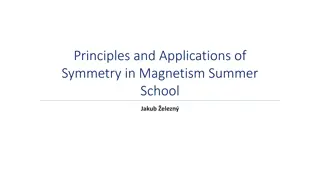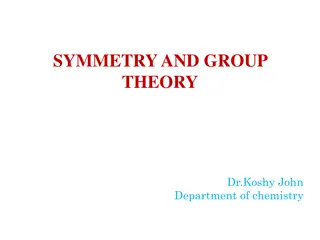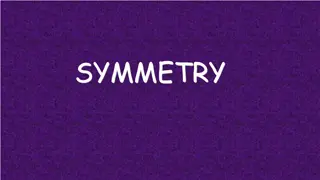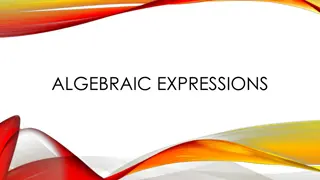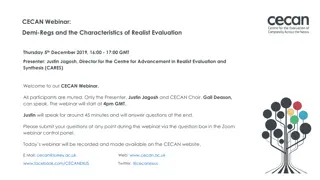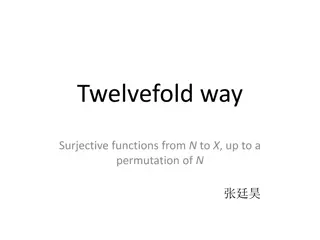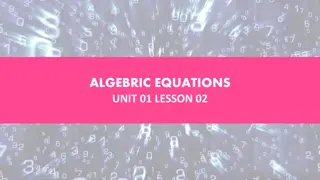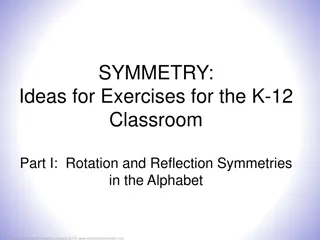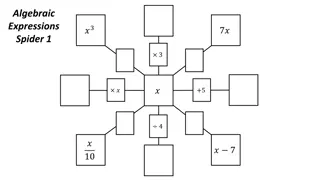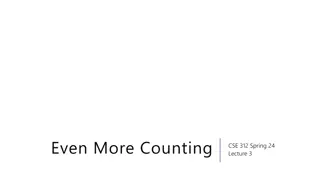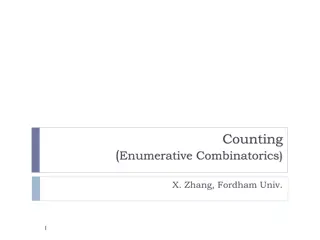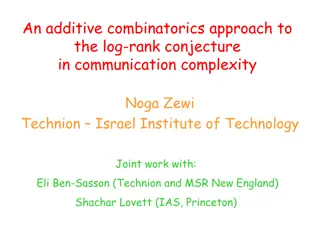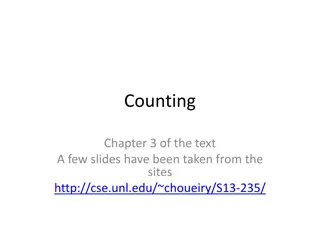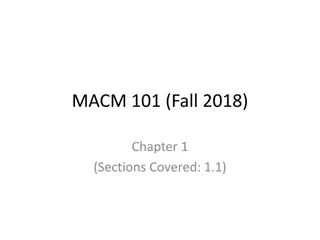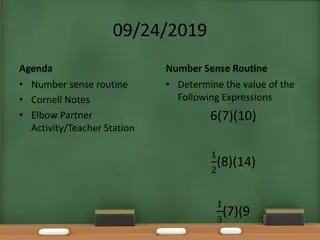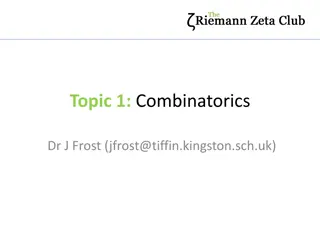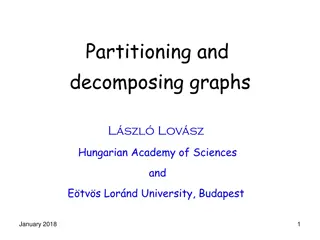Symmetry vs. Regularity: Origins of Algebraic Combinatorics
Igor Faradjev recounts the origin of algebraic combinatorics in the 1968-1990 period at the Institute for Systems Analysis. He reflects on his personal experiences, relationships with key mathematicians, and the innovative work undertaken in the Mathematical Laboratory of the Institute for Theoretical and Experimental Physics. The story highlights the pioneering research in pattern recognition, chess programming, and computer graphics, shedding light on the early development of computational complexity theory in the Soviet Union.
Download Presentation

Please find below an Image/Link to download the presentation.
The content on the website is provided AS IS for your information and personal use only. It may not be sold, licensed, or shared on other websites without obtaining consent from the author.If you encounter any issues during the download, it is possible that the publisher has removed the file from their server.
You are allowed to download the files provided on this website for personal or commercial use, subject to the condition that they are used lawfully. All files are the property of their respective owners.
The content on the website is provided AS IS for your information and personal use only. It may not be sold, licensed, or shared on other websites without obtaining consent from the author.
E N D
Presentation Transcript
Symmetry vs Regularity. How it started and what it led to. Igor Faradjev Institute for Systems Analysis, Federal Research Center Computer Science and Control of Russian Academy of Sciences ifardjev@yahoo.com
The talk is divided into two parts. In the first part my personal vision of the origin and development of algebraic combinatorics in 1968 1990 years is described. In more detail I dwell on the events, in which I either participated himself, or was a direct observer. The second part is devoted to my personal relationship with A. Leman and B. Weisfeiler and the atmosphere in which Soviet mathematicians lived and worked.
This story began in the Mathematical Laboratory of the Institute for Theoretical and Experimental Physics (ITEP). The main function provide mathematical and programming support for physics research and development (calculation of nuclear reactors and accelerators particles, processing the results of observations in cloud chambers, etc.) However, the breadth of interests of the director of the institute, Academician Abram Isaakovich Alikhanov, and the head of the laboratory, Professor Alexander Semenovich Kronrod, enabled the laboratory staff to pursue promising directions in computer mathematics that did not directly relate to the needs of the research of the physical institute. In particular, they were engaged in: of the laboratory was to of elementary scientific
- pattern recognition (prototypes of modern neural networks), - chess programming (the program Kaissa, developed in ITEP and later rewritten to work on more powerful computers, was the first world champion among chess programs), - computer graphics of moving objects (now this is called computer animation).
I started working at the laboratory in the autumn of 1966. I was assigned a workplace in a room with two young mathematicians - Andrey Andreevich Leman and Boris Yulievich Weisfeiler.
Two laboratory at that time: Evgeniy Mikhailovich Landis and Georgy Maximovich Adelson-Velsky. They were the first in the USSR to study the computational complexity of discrete algorithms (do you remember the famous AVL tree?) and they attracted to this area young researchers of the laboratory. At that time, the complexity theory of algorithms took the first steps. The concepts of polynomially solvable and NP-complete problem were introduced and the first lists of problems related to these classes were compiled. It turned out that two practically important problems, linear programming and graph isomorphism, fell out of this classification: no polynomial algorithm was known and neither was NP- completeness proved. outstanding mathematicians worked at the
Subsequently, polynomial algorithm for the linear programming problem, but the situation with the graph isomorphism has not been resolved to this day. The greatest achievement to date is Laszlo Babai s quasipolynomial algorithm (2016). Leonid Khachiyan constructed a Naturally, young mathematicians of the laboratory (V. Arlazarov, B. Weisfeyler, A. Leman, M. Rosenfeld and me) were interested in isomorphism problem. The first result in this direction was the Weisfeiler-Leman algorithm (1968). various aspects of the
Roughly speaking, this algorithm produces a sequential recoloring of the arcs of a complete directed graph. At each iteration, for each arc, the number of triangles with colors from the previous step closing the given arc is determined. The resulting values are ordered as polynomials of colors, and as a result, the new colors of two arcs coincide if and only if their polynomials are the same. The process ends when the differentiation of the arcs of the graph ceases, that is, when any pair of equally colored arcs remains equally colored after the next iteration. In fact, the algorithm builds a coherent configuration, the coherent closure of the graph.
Unfortunately, I do not have any memories of the development of this algorithm. I was either busy with other things, or simply ignored the discussions. At that time, I did not have the mathematical background and did not understand the language of discrete algebra. I became involved in this work later, when practical computations came to the fore.
The next step was made in a series of presentations by B. Weisfeiler and the following discussions at the seminar directed by G.M. Adelson-Welsky and V. Arlazarov at the Institute for Control Problems (ICP). The concepts of cell, cell ring, and cell algebra introduced then were subsequently published by B. Weisfeiler in a collective monograph in Lecture Notes in Mathematics (1976).
Of configurations in which all loops at vertices have the same color (aka associative schemes) and some of their special classes: - configurations painted only in three colors - strongly regular graphs (srg), - distance regular graphs (drg), in which edges are equally colored if and only if they connect pairs of equidistant vertices. special interest are homogenous coherent
For a while, the authors of the algorithm were in a delusion, thinking that the group of automorphisms of a homogenous configuration acts transitively on the vertices of the graph. For example, this would mean that all srg have a transitive group of automorphisms. Apparently, the first doubt in this was expressed by G. Margulis in 1969. Soon (in the same 1969) G. Adelson- Velsky, B. Weisfeyler, A. Leman, and me constructed an srg on 26 vertices with an intransitive automorphism group. Subsequently, L. Babai proved that almost all srg have a trivial automorphism configuration with an intransitive automorphism group and a minimal number of points (14) was discovered by M. Ziv-Av (2015). group. A coherent
Earlier combinatorial constructions, similar to the ones introduced by B. Weisfeiler and A. Leman, repeatedly appeared in group theory (Hecke algebras, Schur rings, centralizer algebras, etc.). It is interesting that the great algebraist Issai Schur was of the same wrong opinion as the authors of the Weisfeiler-Leman algorithm. In view of this, the configurations with the transitive action of the automorphism group on same colored arcs are now called Schurian. It should be noted that algorithms similar to the Weisfeiler-Leman algorithm have until recently been rediscovered with the claim of a polynomial solution to the graph isomorphism problem. The most recent publication of this kind known to me appeared in 2014.
At the end of the last century, repeated attempts were made to generalize the Weisfeiler-Leman algorithm, considering instead of colored subgraphs with a larger number of vertices. A Kharkov physicist A. Golubchik even presented an article, with a description of the corresponding construction (color algebra) and the statement that the problem of graph isomorphism was solved, for publication in the Soviet Mathematics Doklady (with the mediation of M. Klin and me). Fortunately, the article was reviewed by L. Khachiyan who found a fundamental error in the proof. triangles, colored
However, the consideration of subgraphs with a number of vertices greater than 3 led to the notion of a graph with a vertex t-condition generalizing the notion of srg (srg is a graph with 3-condition). This concept was first introduced by M. Hestenes and D. Higman (1971). M. Klin (1983) conjectured that, for a sufficiently large t, the group of automorphisms of a graph with a vertex t- condition is transitive. Now we know graphs with a vertex t-condition and an intransitive automorphism group for all t not exceeding 7. At t = 7 an infinite series of such graphs was constructed by S. Reichard - the student of M. Klin (2014). So, if the Klin conjecture is correct, then for t > 7.
The next breakthrough in the study of coherent configurations was made in the late 70's - early 80's of the last century by two teams of mathematicians. The main idea in this case was to exploit the coupling of coherent configurations and permutation groups - the orbits of the action of the permutation group on pairs of points (2-orbits) are the basic elements of a coherent configuration. The axiomatization of the properties of the 2-orbits of the permutation group led D. Higman (1970) to the notion of a coherent configuration. By the way, D. Higman for several years did not even suspect the existence of the approach of Weisfeiler-Leman. Only after the publication of the book by B. Weisfeiler in 1976 did D. Higman begin to refer to the work of Soviet mathematicians.
A team of Japanese mathematicians (E. Bannai, T. Ito, their students and colleagues) mainly studied associative schemes and distance regular graphs. They managed to transfer the traditional (character theory, representation theory, etc.) to purely combinatorial structures. As a result, a branch of discrete mathematics, entitled "Algebraic Combinatorics" (the theory of groups without groups), generalized the previously used term "Algebraic graph theory". These studies revealed deep configurations with other mathematical structures, in particular, with orthogonal polynomials. The results obtained in these years were published by E. Bannai and T. Ito in the book "Algebraic Combinatorics" (1984), translated into Russian byA.A. Ivanov and me in 1987. group-theoretical methods connections of coherent
Another team, consisting of participants of the seminar for discrete mathematics led by me in the Institute for System Analysis (I. Chuvaeva, Ya. Gol'fand, M. Iofinova, A.A. Ivanov, A.V. Ivanov, D. Pasechnik, S. Shpectorov, V. Zaichenko), and students of the Kiev University professor Lev Arkadievich Kaluzhnin (M. Klin, M. Muzychuk, R. Pochel, V. Ustimenko) focused on the interpretation, enumeration, construction and characterization of combinatorial objects with great homogeneity.
The decisive role in the creation of this team and the themes of their research was played by the annual seminars in Odessa under the leadership of Alexander Aleksandrovich Zykov. In particular, it was at these seminars that the mathematicians of the Moscow and Kiev schools met and began to work together. The progress in these studies was also facilitated by the three combinatorial schools we (Estonia) in 1974, in Sauleskalns (Latvia) in 1975, and in Pushchino in 1977. conducted in Viljandi
In the work of this team, the antimonotone Galois correspondence between the category of coherent configurations on a certain set of points partially ordered by the operation (introduced by M. Klin) of pasting basis elements of the configuration, and the lattice of subgroups of the symmetric group on the same set was mainly exploited. The functors in this correspondence are the operations of constructing the corresponding coherent permutation group and computing the group of automorphisms of the configuration. configuration of the
It is interesting that there exist a class of amorphic associative schemes in antireflexive basis elements leads to an associative scheme. Amorphic schemes were discovered and studied in detail by Ya. Gol'fand and A.V. Ivanov. The beginning of such a study was laid in a two-hour conversation between Ya. Golfand and M. Klin in my presence on the beach in Batumi in 1980. which any pasting of
While asymptotic results can be obtained analytically for many series of permutation groups, for small group sizes, and especially for sporadic simple groups, the study of their permutation representations involvement of computer calculations. V. Zaichenko and me, under M. Klin s direction, developed a complex of programs COCO (COherent COnfiguration), which makes it possible to carry out the necessary calculations with permutation groups and coherent configurations. Thanks to the assistance of Andreas Brouwer, this set of programs became known to many specialists who use computers to study the symmetry of graphs. Later, the capabilities of COCO were significantly expanded by F. Fidler, Ch. Pech and S. Reichard - students of M. Klin. required the
Another branch of algebraic combinatorics, based on the study of finite subgroups of the group of automorphisms of Buekenhout diagram geometries, was developed by A.A. Ivanov and S. Shpectorov. Diagram geometries proved to be a convenient language for describing the "local" properties of highly symmetric graphs, while the initial examples were distance-transitive graphs (dtg), whose automorphism group acted transitively on pairs of equidistant vertices. Classical geometries are simply connected in the topological sense. It turned out that the geometry of sporadic simple groups possesses the same property. It follows that such groups are characterized by the local properties of their subgroups. These studies led to a combinatorial characterization of "large" sporadic simple groups, and one of them J4- was first build constructively.
This team of Soviet mathematicians (later scattered all over the world) obtained a number of combinatorial and group-theoretical results.
Combinatorial results: - solution of the isomorphism problem for certain classes of cyclic graphs, - construction of new highly homogeneous objects (srg, drg, block designs, dtg, primitive and line symmetric graphs), - classification of amorphic coherent configurations.
Group-theoretic results: - correction of a number of inaccurate statements and adding new information in the Atlas of finite simple groups, - combinatorial characterization of some sporadic simple groups, - classification of distances transitive representations of certain classes of finite groups.
Many of the results obtained by our team at the time of the collapse of the USSR were published in the collective monograph "Investigations in Algebraic Theory of Combinatorial Objects", published by the Kluwer Academic Publishers in 1994. We received invaluable assistance in publication fromAndrew Woldar. the preparation of this
It should be noted that our cooperation with Japanese colleagues began thanks to the publication in 1984 of a breakthrough article of A.A. Ivanov on the upper limit on the diameter of distance regular graphs. The contacts with mathematicians from the USA (R. Weiss), Great Britain (P. Cameron, M.W. Liebeck, Netherlands (A.E. Brauer, A.M. Cohen, J.J. Seidel) and Australia (C.E. Praeger) also played an important role in the work of our team. J. Saxl), the
First part of my talk is finished. Next I want to tell about my personal relationship with A. Leman and B. Weisfeiler.
When I met with A. Lehman in 1966, it turned out that we had long been acquainted - in 1952 and 1953 we were in the same young pioneer camp (a Soviet analogue of American scout camp).
At ITEP we were working only for a short time. In the spring of 1968, A.S. Kronrod was fired from the institute and the laboratory was disbanded. The formal reason was the signing by several employees of the laboratory of the letter of "ninety-nine" in defense of the mathematician A.S. Esenin-Volpin. A considerable part of our team was sheltered by Academician V.A. Trapeznikov at the Institute for Control Problems (ICP). Unfortunately, the authorities did not allow A.S. Kronrod to move with us, so Vladimir L vovich Arlazarov became the head of the team. Normal work places in the ICP did not appear right away, so our seminar was held in a very long corridor under the roof of the ICP building.
Andrey continued to work on the problems associated with graph isomorphism, and in 1971 he defended his thesis on the enumeration of all cellular algebras and associative schemes of small order. These were pioneering results. Only 20 years later such problems began to be solved by mathematicians of many countries, including Germany, Israel, USA and Japan.
The Higher Attestation Commission (HAC) sent the thesis for review to Yu.I. Zhuravlev. To the credit of Yuriy Ivanovich, I must say that he delayed as long as he could the negative report demanded of him by the functionary from mathematics S.V. Yablonsky, the famous obscurantist and antisemite, personal enemy of A.S. Kronrod. In the end, the required review was sent to the HAC, and the Expert Council for Mathematics of the HAC, headed by the same S.V. Yablonsky, rejected the thesis. The reason for the refusal was formulated as follows: "This is not mathematics. Subsequently, Andrey bitterly mathematician, I'm a programmer." said: "I'm not a
Unfortunately, after that, Andrey ceased to deal with algebra and combinatorics, but became an algorithmist, system analyst and programmer in other areas - database management systems (DBMS), automated management systems for industry and administration. In 1973 he defended his thesis in this area, and in 1990 he was awarded the USSR Council of Ministers Prize for his participation in the development and implementation of the DBMS INES.
It should be noted that Andrey's interests were not limited to data base programming. In particular, in the late 1970s, at the request of physicists engaged in the study of quantum effects, he wrote a program simulating these effects and visualizing a three- dimensional image on the binocular vision. At that time, this was quite novel and it caused surprise and admiration among his colleagues. display screen using
In 1976, as part of our team, he moved to the Institute for System Analysis (ISA), which was spun from the ICP. In ISA, we worked together until 1990. In 1990 Andrey joined the "landing party" of our group in the Silicon Valley (California), and a year later I joined them. In the startup formed there, the Cognitive Technology Inc, we were engaged in optical recognition systems (OCR). The Cuneiform OCR that we created there was at that time the best in the world. But in the following years the company could not compete and disintegrated, so in 1994- 95, Andrey and I had to join different hi-tech companies. Until my return to Russia in 2009 we lived close to each other and met often. After we began to live in different countries, we maintained telephone and skype relations untilAndrey passed away in 2012.
It is worth noting that Andrey was a mathematician of a brilliant Olympic style. collection of problems of the school mathematical Olympiads of the Moscow State University is still considered one of the best books of this genre. Published in 1965, his
The very list of authors of the problems presented in this collection, from G. Adelson-Velsky and V. Arnold to D. Fuchs and A. Khovansky, is simply amazing. Dozens of brilliant young (at that time) mathematicians, who became members of the world's mathematical elite, were pleased to participate in the training of school children.
Andrey was a reliable colleague and loyal friend. In any activity (including washing the floors and cleaning the room), he would find a highlight, allowing you to go about business without much strain. With great pleasure I remember the business trips with Andrey to Yerevan and Vladivostok, spring kayak trips on the high water and the kayak campaign in Karelia under his leadership.
Andrey had a strong sense of humor. During the preparation for the aforementioned rather long kayaking trip to the uninhabited places of Karelia, someone suggested taking a gun with him to hunt for fresh wildfowl. Andrew categorically instructed to stock up on a variety of fishing gear. "It is immoral to kill birds that fly about their business and do not do anything bad to us. But when I bathe my line and hook and the greedy pike grabs it - it's quite another matter" - he explained in all seriousness. banned this, but
Another example. Andrey drove in the night on the freeway in California well above the speed limit and he was stopped by a policeman who overtook him. There followed such a dialogue: "Why are you going so fast?" - "I'm going with the speed of traffic" - "Where did you see the traffic on an empty highway?" - "Well, you and me." The policeman laughed and dismissed Andrey without issuing a fine to him.
With Boris Weisfeiler everything was much more complicated. Boris was a very reserved person, it was difficult for him to get along with people.
He hated any injustice and antisemitism. So in the process of parting with the ITEP, he grappled with a certain communist party functionary and for that he was expelled from the Komsomol. At the final banquet of the winter school in Viljandi, not having heard the context in which L. Makar-Limanov jokingly used the word contemptuous name for Jews), he tried to fight him. "Zhid" (the Russian
All his vacations Boris spent in solitary hikes in the uninhabited regions of the Far North and the Far East of the USSR. "Resting from people" was his expression. The only exception I know of he made for me in the summer of 1969. In the spring of that year, during a sail boat trip on the Pleshcheyevo participation, our friends drowned. In connection with this tragedy, as well as in view of problems in my family life, I was in a most severe depression, and Boris invited me to join him and wander in the South Taimyr and the Putarana plateau. Lake with my
During the one and a half month route from Norilsk to Lake Kutaramakan, we said no more than two dozen words to each other - there was no need. 40 kilogram backpacks at the beginning of the route (a minimum of personal belongings, sublimated products, a piece of plastic instead of a camping tent, a shotgun, a flare gun, ammunition), with the place of gradually disappearing food occupied with found beautiful pieces of rocks and deer horns.
Boris had no problems with his academic career. Strong algebraist, the author of many works in the area of Lie groups, published in serious journals (including in the Soviet Math. Doklady and Uspekhi Mat. Nauk), he defended his thesis in 1970. In 1975, Boris emigrated to the United States via Vienna. I was among those escorting him to the communication. Boris understood the "jealousy" of the authorities, who did not approve of the communication of Soviet scientists with the emigrants. So until the end of the 1980s, information about him was obtained only through rare private occasions and rumors. train. This ended our
An interesting detail concerns the publication of a collective monograph in Lecture Notes in Mathematics. This book, now legendary, was published with the very active support of J.J. Seidel. Boris was formally the only author - the material was taken out of the USSR illegally, and he did not want to damage his fellow co- authors who remained in the USSR. Immediately after the publication of the book, he pasted on all available copies of the book a sticker reading "Edited by B.Yu. Weisfeiler". And now this book is referred to in exactly this way.
Unfortunately, many of the scientists mentioned (A.I. Alikhanov, A.S. Kronrod, E.M. Landis, J.J. Seidel, A.A. Zykov, G.M. Adelson-Velsky, L.A. Kaluzhnin, B.Yu. Weisfeiler, L. Khachian, Ya.Yu. Gol'fand, V.A. Zaichenko, M.E. Iofinova, A.A. Leman) have already left us. We remember them, they are always with us.
I apologize to a large number of colleagues and simply worthy people who supported us in a difficult period of life, which I could not personally mention. I am grateful to my wife Lucy Lukashina, as well as to colleagues V.L. Arlazarov, A.A. Ivanov, M.H. Klin and I.N. Ponomarenko who carefully studied the draft of this text and made significant comments on the style of presentation and terminology. They also corrected my weakening memory regarding the dates and sequence of events. I am also grateful to S. Shpectorov and M. Muzychuk for help in making this presentation.


